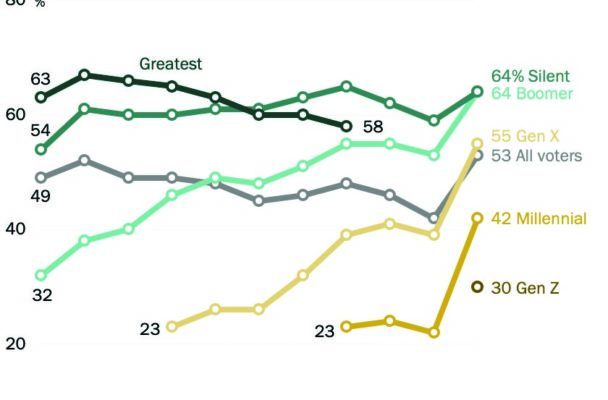Analysts find trends in young voters’ choices

The proportion of eligible millennials who are participating in elections is increasing sharply based on previous trends. Image by Pew Research Center
By Nicholas Bainbridge
News Editor
The election to determine the president of the United States is underway, but recent polling reveals trends in young voters that researchers are using to estimate the results of the next election.
While COVID-19 and other factors impose restrictions that get in the way of many people’s ability to vote, young people are finding ways to ensure their vote is counted. More than 140,000 voters younger than 30 have already submitted mail-in ballots. Colleges are implementing voting assistance programs, like HPU Votes at High Point University, to aid in the voting process and reduce the barriers that external forces cause.
Young voters, such as the majority of HPU’s students, are projected to be more involved in this election than they were in the previous bid for the presidency. According to The CIRCLE, a research center at Tufts University, there are 740,000 new North Carolina voters under the age of 30, making up 42% of this election’s new voters, compared to 13% in 2016.
The proportion of new voters in the 18-29 age range is impactful when one considers that in North Carolina, a quarter of all registered voters are new voters.
Simon Rosenberg, president of the New Policy Network, is a political analyst that has been studying the voting patterns of people in the 18-29 age bracket. He reached out to the Campus Chronicle to explain his findings and their consequences.
“There is a lot of indication based on polling from sources, such as the Harvard Youth Poll, that the intent to vote for young people in this election is the highest it has ever been,” Rosenberg said.
This is a continuing increase from 2018, which also had an above-average voter turnout for young people in local elections. Rosenberg attributed this trend to how politics are unavoidable in young people’s lives and how their importance is better recognized.
“Young people have a much greater understanding of how government decisions impact their lives now,” Rosenberg said.
Rosenberg believes that the 18-29 age bracket has the potential to influence the result of the election.
“Young people’s voting habits are irregular because of their sheer size,” Rosenberg said. “The variance this can have on an election can be enormous. Young people’s uncertainty is very influential, compared to older people who have already solidified their views and are less likely to change their side on issues.”
Another discovery identified by The CIRCLE is that young people are increasingly showing more support for Joe Biden than President Donald Trump. There has been a trend of young people voting for Democrats, and it is continuing to grow.
Current data suggests that Biden will either match or exceed former President Barack Obama’s notably high support from young voters in 2008. This is so substantial that it leads Rosenberg to question the continued existence of the Republican Party.
“Since 2006, there has been a yawning gap between the Democrats and Conservatives in terms of their support from young people,” Rosenberg said. “It goes up and down each year, but the current gap is unprecedented. It will make it very hard for the Republicans to remain a national party if things continue like this. Republicans will need to focus on learning how to appeal to young people if they want to remain influential.”
The reliance on polling to make theories about the future of the country is prone to raise questions from critics. There were numerous national polls during the 2016 election. Some, such as the one done by Reuters that was released the day of Trump’s win, asserted Hillary Clinton had a 90% chance of winning. But she lost, so are polls worth paying attention to if they are wrong?
Rosenberg believes that this is a malformed critique of polls. He says that the 2016 polls were correct but were limited because of last-moment changes.
“The polls were not wrong in 2016, but they changed a lot at the end with the Comey letter,” Rosenberg said. “The state poll data has lower quality because it doesn’t keep up with recent changes. You’ve got to look at federal polls and the averages of them, not just a specific one.”
The “Comey letter” refers to a document sent by former FBI Director James Comey on Oct. 28, 2016, to Congress that reopened the topic of Clinton’s private email scandal. Allegations of corruption involving her emails were a major focus during the 2016 race. Rosenberg explained that the impact of this caused a shift during the closing stages of the election and allowed for Trump’s victory.
What this means is that the polls may still be useful sources of information, so long as there is no major revelation brought to the public’s attention before the election ends.